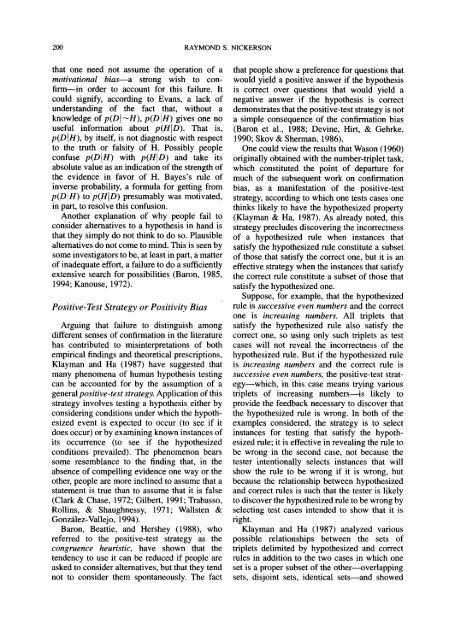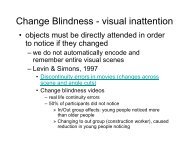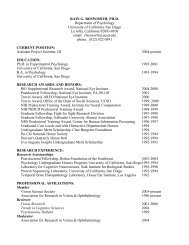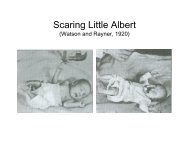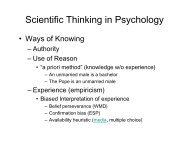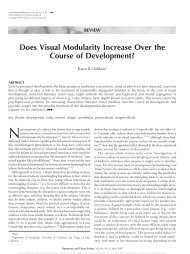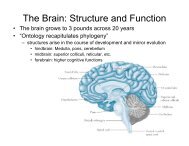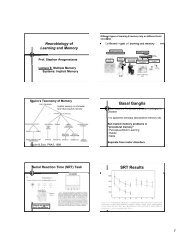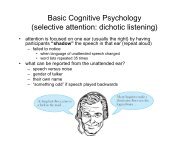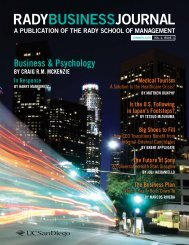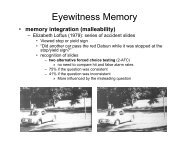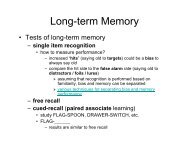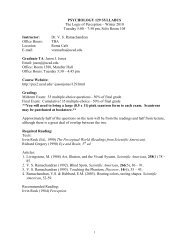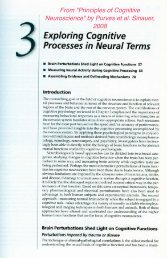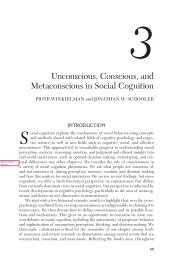Confirmation Bias: A Ubiquitous Phenomenon in Many Guises
Confirmation Bias: A Ubiquitous Phenomenon in Many Guises
Confirmation Bias: A Ubiquitous Phenomenon in Many Guises
Create successful ePaper yourself
Turn your PDF publications into a flip-book with our unique Google optimized e-Paper software.
200 RAYMOND S. NICKERSON<br />
that one need not assume the operation of a<br />
motivational bias—a strong wish to confirm—<strong>in</strong><br />
order to account for this failure. It<br />
could signify, accord<strong>in</strong>g to Evans, a lack of<br />
understand<strong>in</strong>g of the fact that, without a<br />
knowledge of p(D\~H), p(D\H) gives one no<br />
useful <strong>in</strong>formation about p(H\D). That is,<br />
p(D\H), by itself, is not diagnostic with respect<br />
to the truth or falsity of H. Possibly people<br />
confuse p(D\H) with p(H\D) and take its<br />
absolute value as an <strong>in</strong>dication of the strength of<br />
the evidence <strong>in</strong> favor of H. Bayes's rule of<br />
<strong>in</strong>verse probability, a formula for gett<strong>in</strong>g from<br />
p(D\H) to p(H\D) presumably was motivated,<br />
<strong>in</strong> part, to resolve this confusion.<br />
Another explanation of why people fail to<br />
consider alternatives to a hypothesis <strong>in</strong> hand is<br />
that they simply do not th<strong>in</strong>k to do so. Plausible<br />
alternatives do not come to m<strong>in</strong>d. This is seen by<br />
some <strong>in</strong>vestigators to be, at least <strong>in</strong> part, a matter<br />
of <strong>in</strong>adequate effort, a failure to do a sufficiently<br />
extensive search for possibilities (Baron, 1985,<br />
1994; Kanouse, 1972).<br />
Positive-Test Strategy or Positivity <strong>Bias</strong><br />
Argu<strong>in</strong>g that failure to dist<strong>in</strong>guish among<br />
different senses of confirmation <strong>in</strong> the literature<br />
has contributed to mis<strong>in</strong>terpretations of both<br />
empirical f<strong>in</strong>d<strong>in</strong>gs and theoretical prescriptions,<br />
Klayman and Ha (1987) have suggested that<br />
many phenomena of human hypothesis test<strong>in</strong>g<br />
can be accounted for by the assumption of a<br />
general positive-test strategy. Application of this<br />
strategy <strong>in</strong>volves test<strong>in</strong>g a hypothesis either by<br />
consider<strong>in</strong>g conditions under which the hypothesized<br />
event is expected to occur (to see if it<br />
does occur) or by exam<strong>in</strong><strong>in</strong>g known <strong>in</strong>stances of<br />
its occurrence (to see if the hypothesized<br />
conditions prevailed). The phenomenon bears<br />
some resemblance to the f<strong>in</strong>d<strong>in</strong>g that, <strong>in</strong> the<br />
absence of compell<strong>in</strong>g evidence one way or the<br />
other, people are more <strong>in</strong>cl<strong>in</strong>ed to assume that a<br />
statement is true than to assume that it is false<br />
(Clark & Chase, 1972; Gilbert, 1991; Trabasso,<br />
Roll<strong>in</strong>s, & Shaughnessy, 1971; Wallsten &<br />
Gonzalez- Vallejo, 1994).<br />
Baron, Beattie, and Hershey (1988), who<br />
referred to the positive-test strategy as the<br />
congruence heuristic, have shown that the<br />
tendency to use it can be reduced if people are<br />
asked to consider alternatives, but that they tend<br />
not to consider them spontaneously. The fact<br />
that people show a preference for questions that<br />
would yield a positive answer if the hypothesis<br />
is correct over questions that would yield a<br />
negative answer if the hypothesis is correct<br />
demonstrates that the positive-test strategy is not<br />
a simple consequence of the confirmation bias<br />
(Baron et al., 1988; Dev<strong>in</strong>e, Hirt, & Gehrke,<br />
1990; Skov & Sherman, 1986).<br />
One could view the results that Wason (1960)<br />
orig<strong>in</strong>ally obta<strong>in</strong>ed with the number-triplet task,<br />
which constituted the po<strong>in</strong>t of departure for<br />
much of the subsequent work on confirmation<br />
bias, as a manifestation of the positive-test<br />
strategy, accord<strong>in</strong>g to which one tests cases one<br />
th<strong>in</strong>ks likely to have the hypothesized property<br />
(Klayman & Ha, 1987). As already noted, this<br />
strategy precludes discover<strong>in</strong>g the <strong>in</strong>correctness<br />
of a hypothesized rule when <strong>in</strong>stances that<br />
satisfy the hypothesized rule constitute a subset<br />
of those that satisfy the correct one, but it is an<br />
effective strategy when the <strong>in</strong>stances that satisfy<br />
the correct rule constitute a subset of those that<br />
satisfy the hypothesized one.<br />
Suppose, for example, that the hypothesized<br />
rule is successive even numbers and the correct<br />
one is <strong>in</strong>creas<strong>in</strong>g numbers. All triplets that<br />
satisfy the hypothesized rule also satisfy the<br />
correct one, so us<strong>in</strong>g only such triplets as test<br />
cases will not reveal the <strong>in</strong>correctness of the<br />
hypothesized rule. But if the hypothesized rule<br />
is <strong>in</strong>creas<strong>in</strong>g numbers and the correct rule is<br />
successive even numbers, the positive-test strategy—which,<br />
<strong>in</strong> this case means try<strong>in</strong>g various<br />
triplets of <strong>in</strong>creas<strong>in</strong>g numbers—is likely to<br />
provide the feedback necessary to discover that<br />
the hypothesized rule is wrong. In both of the<br />
examples considered, the strategy is to select<br />
<strong>in</strong>stances for test<strong>in</strong>g that satisfy the hypothesized<br />
rule; it is effective <strong>in</strong> reveal<strong>in</strong>g the rule to<br />
be wrong <strong>in</strong> the second case, not because the<br />
tester <strong>in</strong>tentionally selects <strong>in</strong>stances that will<br />
show the rule to be wrong if it is wrong, but<br />
because the relationship between hypothesized<br />
and correct rules is such that the tester is likely<br />
to discover the hypothesized rule to be wrong by<br />
select<strong>in</strong>g test cases <strong>in</strong>tended to show that it is<br />
right.<br />
Klayman and Ha (1987) analyzed various<br />
possible relationships between the sets of<br />
triplets delimited by hypothesized and correct<br />
rules <strong>in</strong> addition to the two cases <strong>in</strong> which one<br />
set is a proper subset of the other—overlapp<strong>in</strong>g<br />
sets, disjo<strong>in</strong>t sets, identical sets—and showed


